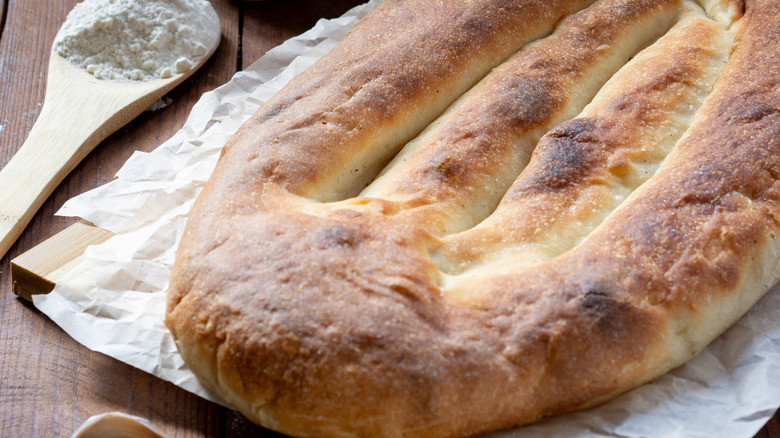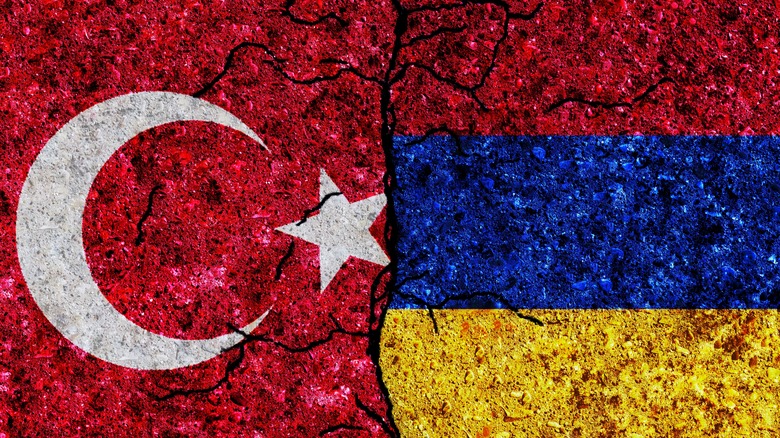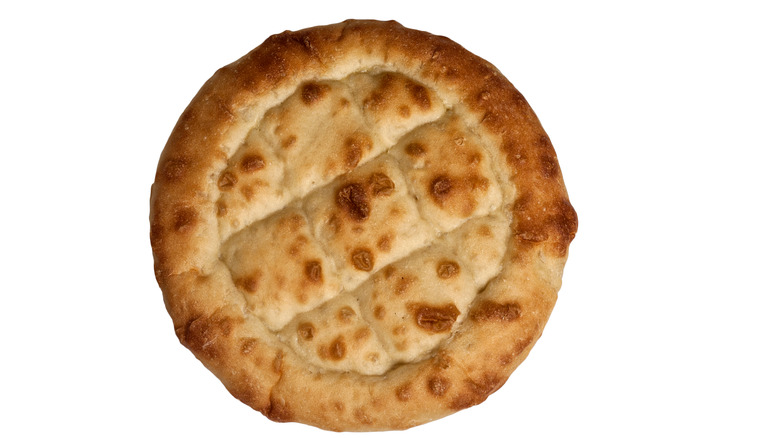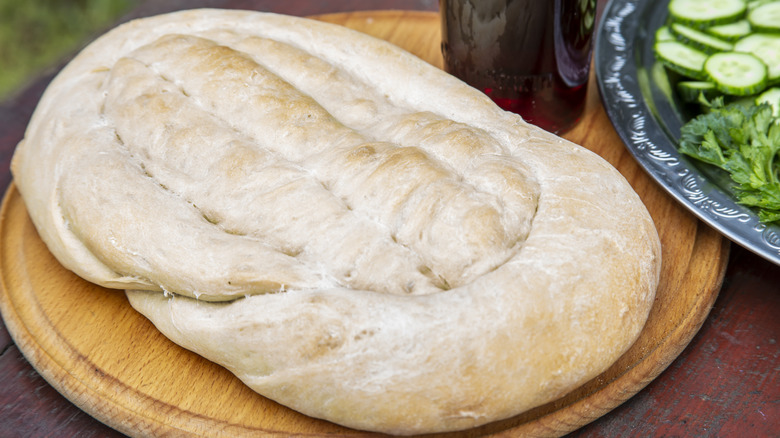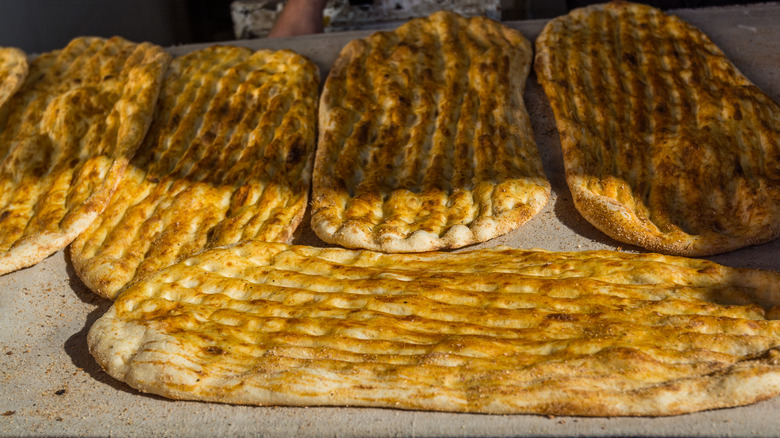What Makes Armenian Fingerprint Flatbread Unique
It is a commonly held belief that bread, in all its various forms, is the most important culinary invention of all time. Found in cultures across the world and made with a wide range of diverse ingredients, bread has been a global staple since our ancient ancestors baked the first loaf over 30,000 years ago, via History of Bread. Among the most iconic breads in the world include the classic French baguette, Italian ciabatta, sourdough boule, and pita.
The nation of Armenia, which sits in the middle of the Caucasus — the mountainous region that divides Europe and Asia — has a special relationship with bread. According to Saveur, bread and meal are the same words in Armenian. The most well-known Armenian bread is, of course, lavash. This iconic bread is rolled long and thin and baked on the walls of a traditional tonir oven. However, Armenia is more than lavash alone. There are several different types of bread found throughout the nation, each sharing a special history with the part of Armenia in which it was created.
One such bread is matnakash or fingerprint flatbread. This bread carries an extra special significance, as its shape and unique design symbolize specific components of Armenian history, while its flavor and consistency offer a nice alternative to the more rustic lavash.
Of east and west
As is unfortunate for many nations, the present state of Armenia is not as united as it once was. According to the United Nations, Armenia has been divided between East and West for centuries. The present divide occurred at the start of the 19th century when the West came under the rule of the Ottomans, and the Russians took control in the East. While the Soviet state of Armenia eventually fell with the collapse of the Soviet Union, resulting in the formation of the modern Armenian Republic, the question of Western Armenia is still an international political tension point.
There is reason to bring up this delicate situation. According to Andrew Janjigian, writing for King Arthur Baking, growing up in Turkish-controlled Western Armenia left him as an ethnic Armenian who had never eaten matnakash. The fluffy flatbread was only available to the East, in the Republic. As Saveur states, bread is vital for all Armenians, regardless of political boundaries. Since Armenia is as diverse as any nation regarding regional cooking preferences, different breads will be found in different parts of the country. Matnakash, however, is second only to lavash as Armenia's national bread, per Armenia Discovery. This status was elevated thanks partly to the bread preferences of the Iron Curtain.
Soviet food propaganda
Matnakash is by no way an invention of the Soviets, though their flare for propaganda has stuck to it like egg wash. The traditional serving of matnakash is a table bread paired with a larger entree or a collection of smaller bites. The bread is also notable for its distinctive look, somewhat akin to Italian focaccia. Matnakash is ovular or round, with an outer ring and defined middle section riddled with dimples. These dimples are made by bakers pressing their fingers into the dough to form peaks and valleys throughout the center of the bread. This technique also gives the bread its distinctive fingerprint name, as matnakash is Armenian for "drawn by fingers," via KPBS.
What does this have to do with the Soviets? According to King Arthur Baking, during the period Armenia was under the thumb of the USSR, the Soviets took to matnakash for its texture, which is more bread-like than most flatbreads, and unique shape. The dimples in the bread appeared to the Soviets to look like parallel rows of plowed wheat fields. The propagandists of the would-be socialist empire reinvented the meaning of the bread's style to represent the agrarian might of the Block. The dimples actual purpose is to hold onto the glaze and give the bread air, thus leading to its favored texture.
How to make matnakash
Matnakash is simple to make. It's based on a sourdough start, which gives the bread its tangy flavor and characteristic fluffiness. Getting started on a loaf of matnakash involves mixing flour, water, and salt. You can use store-bought yeast, but if you're looking for the soft texture and fermented bite matnakash is traditionally known for, it's best to start with a sourdough base. The mix proofs in the fridge overnight, increasing the complexity of the bread's flavors, via King Arthur Baking. After the proofing period comes the fun part: giving the bread its signature dimples. According to KPBS, this is an easy technique of stretching the dough with your fingertips and pushing them through the dough until you feel the work surface underneath, thereby creating valleys and peaks.
Between final proofing and dimpling comes glazing, which can change the character of the bread. Egg wash is commonly used to brown the exterior, giving the loaf a golden color while also serving as glue for toppings to adhere to. The quick browning creates a protective outer shell that keeps the bread from overcooking. You needn't be limited to just egg wash. Andrew Janjigian found in his research for King Arthur that glazes such as date syrup, yogurt, water and honey, and pomegranate molasses have all been used to flavor matnakash, making it a bread that can adapt to numerous meal settings.
Other regional 'fingerprint' breads
Armenian matnakash is hardly the only fingerprint-style flatbread in the region. According to KPBS, other breads such as Iranian barbari, Afghan naan, and Turkish pide share common ancestry with matnakash. This is likely because these nations were once part of the great Persian Empire of ancient history. Before falling to Alexander the Great, the Persian Empire covered virtually all of the modern Middle East, including Turkey, Iran, Afghanistan, Armenia, Israel, Egypt, and Iraq, per History.com.
Iranian barbari bread is perhaps closest in style to Armenian matnakash. Barbari bread, simply called naan in Iran, is long and thin. The loaves need to be at least 30 inches long, 1 foot wide, and about 1 inch thick, making it more of a rectangle than the ovular matnakash. Skinny trenches or fingerprint dimples run the length of the bread. It is washed with an egg coating for a golden brown color and is traditionally topped with sesame seeds. The resulting bread is crisp on the outside and fluffy on the inside (via 196 Flavors). Armenia and its neighbors are not short on bread. As evidenced by history and modern proclivities, bread is significant to the diverse cultures of the Middle East and Caucasus regions and will likely remain so forever.
